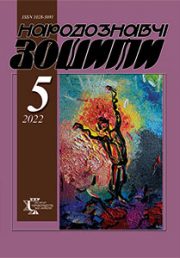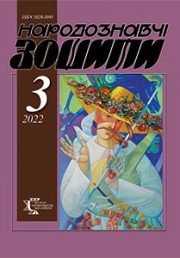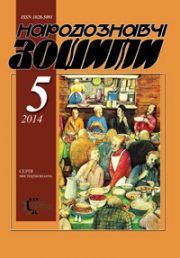The Ethnology Notebooks. 2020. № 5 (155), 1128—1143
UDK [391:658.341.353](477.41./42-15)
DOI https://doi.org/10.15407/nz2020.05.1128
LIME-BAST FOOTWEAR OF POLISSIA RESIDENTS IN THE WESTERN POLISSIA ETHNO-CULTURAL FRONTIER AREA
Bulhakova-Sytnyk Ludmyla
- ORCID ID: https://orcid.org/0000-0003-0123-7854
- Ph. D. of Historical Sciences,
- Researcher of the Institute of Ethnology of the National Academy
- of Sciences of Ukraine, Fellow of the Museum of Ethnography and Art Crafts
- Svobody Avenue, 15, 79000. Lviv. Ukraine
- Contacts: e-mail: lbulhakova@gmail.com
Abstract. The article constitutes an attempt to make comprehensive analysis of archaic lime-bast foorwear of Western Polissia Ukrainians, enabling its historical reconstruction. Topicality of the research into traditional footwear lies in a considerable expansion of the range of problems lying in the plain of the history of daily life, an important part of which is labour activity of residents within the system of natural and climatic conditions. Important scientific interest presents the study of mutual effects in the field of clothing culture of the residents of the Ukrainian-Belarus frontier area, in particular, traditional footwear.
The goal of the research is to make comprehensive analysis of the manufacturing technologies, ways of wearing and local names of lime-bast footwear in the area of interethnic contacts of Ukrainian and Belarus people, identification of characteristic regional features of the object under research.
The object of the research is archaic peasant footwear made of lime bast and its components, while the subject of the research is the data about raw materials, wickerwork techniques, ways of wearing, and local names. Materials collected in more than 300 inhabited settlements of Kyiv, Zhytomyr, Rivne, and Volyn regions of the ethnographic region of Polissia were taken as the source of the study. Materials from other regions of Ukraine and Belarus; printed materials containing mentions of Polissia residents’ traditional footwear were also involved for comparison purposes.
The chronological framework is determined by the thematic direction and the task of the research and embrace the period of the first half of the ХХth c. The territorial limits include the territory of Western Polissia.
The methodological framework of the research includes general scientific principles of historical analysis. Comparative historical, descriptive method and cartography method were used in the problem research.
The materials of the research can be used for writing special and generalizing papers in the history of traditional clothing of Ukrainians; historical reconstruction of lime-bast footwear; preparation of museum expositions.
Keywords: Western Polissia, Ukrainian-Belarus interethnic frontier area, traditional lime-bast footwear, voloky, lapti (bast shoes), lychaky (bast sandals), postoly (sandals strapped to the feet).
Received 12.10.2020
REFERENCES
- Horlenko, W. (2001). Lytwyns of North of Ukraine — possible debris of forefathers of annalistic severians’ tribe (comment of Pawlo Gryzenko) — PU № 1—2. Retrieved from: http://donklass.com/arhiv/histdisk/heritage/heritage/istorija/doslidzhennja/HorlSiveryzn/HorlSiveryan03.htm.
- Moros, M.A., & Tshakwin, I.W. (1988). Polissia as historical-ethnographic region, its localization and borders. Polissia. Material culture (Pp. 28—39). Kyiv [in Ukrainian].
- Hlushko, M. (2009). On ethnographic regionalization of Ukraine: the state, the problems and the tasks (based on research works of the second half of the XXth and early XXIth centuries). Visnyk of Lviv university. Historical series (Issue 44, pp. 179—214). Lviv [in Ukrainian].
- (1996). Albums by Dominique Pierre de la Flise (Vol. 1). Kyiv [in Ukrainian].
- (1877). Works of the Ethnographic-Statistical Expedition to the West-Russian Region: proceedings and research, collected by Chubynsky P. (Vol. 7, issue 2, pp. 312—389). St. Petersburg [in Russian].
- Moszynski, K. (1929). Folk culture of slavs. Material culture (Part 1, section 16). Krakow [in Polish].
- (2012). The Belarusians in the photos by Isaac Serbau. 1911—1912. Minsk [in Belarus].
- Jуzef, Obrкbski. (2007). Polesye. Warszaw [in Polish].
- Maslova, G.S. (1956). Folk clothing of Russians, Ukrainians and Byelorussians in XX — the early XXth. East-Slavic ethnographical collection (Pp. 543—750). Moscow [in Russian].
- Mateyko, К.І. (1977). Ukrainian folk clothing. Kyiv [in Ukrainian].
- Nikolayeva, Т. (1988). Ukrainian folk clothing: Middle Dnieper region. Kyiv [in Ukrainian].
- Nikolayeva, T. (1996). History of the Ukrainian costume. Kyiv [in Ukrainian].
- Bilan, М.S., & Stelmashchuk, G.G. (2011). Ukrainian dress complex. Lviv [in Ukrainian].
- Sokolovskaya, A.S. (1968.) The name of clothing and shoes of Polessye. Vocabulary of Polessye. The researches for dialect dictionary of Polessye (Pp. 281—320). Moscow [in Russian].
- Nykontshuk, M.V. (Ed.). (1998). The name of clothing and shoes right-bank Polissya. Zhytomyr [in Ukrainian].
- Grymashevych, G. (2002). Nomination of clothing and footwear in the medium Polissya dialect. Zhytomyr [in Ukrainian].
- Grymashevych, G. (2007). Medium Polissya Hutsul lexical-semantic parallels (based on the names of clothes and shoes). Volyn philological: text and context (Issue 4, pp. 56—62). Lutsk [in Ukrainian].
- Mateyko, К.І. (1996). Ukrainian folk clothing. Ethnographical dictionary. Kyiv [in Ukrainian].
- Ponomar, L. (1997). The names of West Polissya clothing. Kyiv [in Ukrainian].
- Kurylowitsh, G.M., & Byalyavina, W.M. (1975). Outergarments and shoose. Belarusian folk clothing (Pр. 59—71). Minsk [in Belarus].
- Ponomar, L. (2015). Folk Clothes of Right-Bank Polissia in the mid-XIXth to mid-XXth century. Kyiv [in Ukrainian].
- Romanov, E.R. (1912). Life of Belarusian. Belarusian collection (Issue 8—9). Vilna [in Lithuania].
- Moltshanova, L.A. (1968). Material Culture of Belarusians. Minsk [in Belarus].
- Melnytshuk O.S. (Ed.). (1989). Etymological dictionary of Ukrainian language (Vol. 3). Kyiv [in Ukrainian].
- Picura, T. (2008). Archaic name shoes in Ukrainian Carpathian dialects. Uzhhorod university scientific bulletin. Series: Philology (Issue 18, pp. 77— 80). Uzhhorod [in Ukrainian].
- Surhutova, N. History of sandals. Retrieved from: http://vk.com/topic-26653328_27172683.
- Fasmer, M. (1987). Etymological dictionary of Russian language: in 4 vol. (Vol. III). Moscow [in Russian].
- Babiy, F.J. (1982). The names of clothing and shoes in Rivnenshchyna’s subdialect from their origin point of view. The vocabulary of Ukrainian language considering its relations with Slavic and non-Slavic languages (Pp. 72—74). Uzhhorod [in Ukrainian].
- Hrintshenko, B.D. (1908). The dictionary of Ukrainian language (Vol. 3). Kyiv [in Ukrainian].
- Titov, V.S., & Schlachtovskyy, A.S. (1998). The nature of Polissya. Polissya. Material culture (Pp. 40—49). Kyiv [in Ukrainian].
- Moszynski, K. (1928). East Polissya . Warszaw [in Polish].
- Ukrainez, A. (2019). Traditional clothing of Rivnenshchyna. Rivne [in Ukrainian].
- (2010). Ukraine in folk types, landscapes and architecture. Kyiv [in Ukrainian].
- Byalayavina, V.M., & Rakava, L.V. (2007). Male clothing in Belarussian. Minsk [in Belarus].
- Bulhakova, L. (1996). Folk clothing of population of Kyiv Polissya (the 20—30-ties of the ХХ century). Polissya of Ukraine: materials of historical-ethnographical research. Kyiv Polissya. 1994 (Issue 1, pp. 123—147). Lviv [in Ukrainian].
- Bulhakova, L. (1999). Traditional woman’s clothing of the first part of the ХХ century. Polissya of Ukraine: materials of historical-ethnographical research. Ovruchchyna. 1995 (Issue 2, pp. 159—178). Lviv [in Ukrainian].
- Zachartshuk-Tshuhay, R. (2007). Folk decorative art of Ukrainian Polissya: Chornobyl. Lviv [in Ukrainian].
- Ukrainets, A. (2009). Folk clothing. Ethnoculture of Rivne` Polissya (Pр. 29—62). Rivne [in Ukrainian].
- Byalayavina, V.M., & Rakava, L.V. (2007). Female clothing in Belarussian. Minsk [in Belarus].
- Burakoyskaya, N.I. (1989). Sandals. Ethnography of Belarussian (Pp. 285—286). Minsk [in Belarus].
- Zelenin, D.K. (1991). The East Slavs ethnography. Moscow [in Russian].
- Rags. Retrieved from: https://uk.wikipedia.org › wiki ›.






